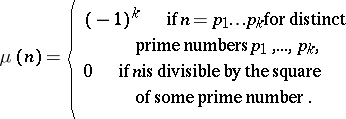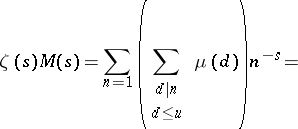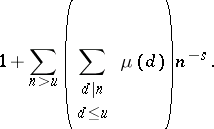Vaughan identity
In 1937, I.M. Vinogradov [a9] proved the odd case of the Goldbach conjecture (cf. also Goldbach problem); i.e., he proved that every sufficiently large odd number can be written as a sum of three prime numbers (cf. also Vinogradov method). The essential new element of his proof was a non-trivial estimate for an exponential sum involving prime numbers (cf. also Exponential sum estimates). Let  denote
denote  and let
and let  , where
, where  runs over the prime numbers. By simply observing that
runs over the prime numbers. By simply observing that  for all
for all  ,
,  and using the prime number theorem (cf. de la Vallée-Poussin theorem), one immediately sees that
and using the prime number theorem (cf. de la Vallée-Poussin theorem), one immediately sees that  . Vinogradov was able to improve on this estimate on the "minor arcs" ; in other words, he obtained a better estimate for those values of
. Vinogradov was able to improve on this estimate on the "minor arcs" ; in other words, he obtained a better estimate for those values of  that could not be well approximated by a rational number with a small denominator. Vinogradov's estimate used the sieve of Eratosthenes (cf. also Eratosthenes, sieve of; Sieve method) to decompose the sum
that could not be well approximated by a rational number with a small denominator. Vinogradov's estimate used the sieve of Eratosthenes (cf. also Eratosthenes, sieve of; Sieve method) to decompose the sum  into subsums of the form
into subsums of the form
 |
and of the form
 |
The sums have become known as sums of type I and type II, respectively.
Vinogradov's method is quite powerful and can be adapted to general sums of the form  . However, the technical details of his method are formidable and, consequently, the method was neither widely used nor widely understood. In 1977, R.C. Vaughan [a6] found a much simpler approach to sums over prime numbers.
. However, the technical details of his method are formidable and, consequently, the method was neither widely used nor widely understood. In 1977, R.C. Vaughan [a6] found a much simpler approach to sums over prime numbers.
Vaughan's identity is most easily understood in the context of Dirichlet series. Suppose that
 |
are both absolutely convergent in the half-plane  . Then
. Then
 |
in this same half-plane. One of the simplest and most useful Dirichlet series is the Riemann zeta-function (cf. also Zeta-function), which is defined as  for complex numbers
for complex numbers  with real part exceeding
with real part exceeding  . The Euler product formula states that
. The Euler product formula states that
 |
where the product is over all prime numbers  . Taking the reciprocal of the Euler product, one sees that
. Taking the reciprocal of the Euler product, one sees that
 |
where  is the Möbius function defined by
is the Möbius function defined by
 |
By looking at the coefficients of  , one obtains the useful identity
, one obtains the useful identity
 |
By taking the logarithmic derivative of the Euler product formula, one sees that
 |
where the coefficients  are defined as
are defined as
 |
This is the Mangoldt function. By computing the product
 |
in two different ways, one sees that
 |
For technical reasons, it is often simpler to work with sums of the form  than with sums of the form
than with sums of the form  , and estimates for the latter sum can usually be easily derived from estimates for the former.
, and estimates for the latter sum can usually be easily derived from estimates for the former.
Let  ,
,  be arbitrary real numbers, both exceeding
be arbitrary real numbers, both exceeding  , and define
, and define
 |
Thus,  and
and  are partial sums of
are partial sums of  and
and  respectively. In particular,
respectively. In particular,
 |
 |
Now consider the Dirichlet series identity
 |
Comparing coefficients of  on both sides of the equation, one sees that if
on both sides of the equation, one sees that if  , then
, then
 |
where
 |
If one multiplies this equation by  and sums over
and sums over  , one obtains the Vaughan identity:
, one obtains the Vaughan identity:
 |
 |
 |
 |
In general, the first and second sums can be treated as type-I sums, and the third sum can be treated as a type-II sum. The logarithm factor in the first sum is easily finessed with partial summation. In some applications, it is useful to divide the second sum into subsums with  and
and  , where the first subsum is treated as type-I and the second subsum as type-II.
, where the first subsum is treated as type-I and the second subsum as type-II.
For a brief and very accessible account of how Vaughan's identity is applied, see Vaughan's original article [a6]. There, he proves that
 |
 |
whenever  . Another self-contained account of this can be found in [a1].
. Another self-contained account of this can be found in [a1].
There are many applications of Vaughan's identity in the literature. Vaughan [a7] used it to obtain new estimates on the distribution of  , and he also used it to give an elegant proof of the Bombieri–Vinogradov theorem on prime numbers in arithmetic progressions [a8]. H.L. Montgomery and Vaughan [a5] obtained a new estimate for the error term in the formula for the number of square-free integers up to
, and he also used it to give an elegant proof of the Bombieri–Vinogradov theorem on prime numbers in arithmetic progressions [a8]. H.L. Montgomery and Vaughan [a5] obtained a new estimate for the error term in the formula for the number of square-free integers up to  , conditional on the Riemann hypothesis (cf. Riemann hypotheses). This requires a slightly different form of Vaughan's identity. In this case, let
, conditional on the Riemann hypothesis (cf. Riemann hypotheses). This requires a slightly different form of Vaughan's identity. In this case, let  be as before, but take
be as before, but take
 |
From the equation
 |
one can obtain an identity for sums of the form  . D.R. Heath-Brown and S.J. Patterson [a3] used Vaughan's identity to prove a long-standing conjecture of E. Kummer about distribution of cubic Gauss sums (cf. also Kummer hypothesis; Gauss sum). Heath-Brown [a2] developed a more general and more flexible version of Vaughan's identity, and G. Harman [a4] has developed an alternative treatment that returns to Vinogradov's original idea of using the sieve of Eratosthenes (cf. also Eratosthenes, sieve of).
. D.R. Heath-Brown and S.J. Patterson [a3] used Vaughan's identity to prove a long-standing conjecture of E. Kummer about distribution of cubic Gauss sums (cf. also Kummer hypothesis; Gauss sum). Heath-Brown [a2] developed a more general and more flexible version of Vaughan's identity, and G. Harman [a4] has developed an alternative treatment that returns to Vinogradov's original idea of using the sieve of Eratosthenes (cf. also Eratosthenes, sieve of).
References
| [a1] | H. Davenport, "Multiplicative number theory" , Springer (1980) (Edition: Second) |
| [a2] | D.R. Heath-Brown, "Prime numbers in short intervals and a generalized Vaughan identity" Canad. J. Math. , 34 (1982) pp. 1365–1377 |
| [a3] | D.R. Heath-Brown, S.J. Patterson, "The distribution of Kummer sums at prime arguments" J. Reine Angew. Math. , 310 (1979) pp. 110–130 |
| [a4] | G. Harman, "Eratosthenes, Legendre, Vinogradov, and beyond" G.R.H. Greaves (ed.) G. Harman (ed.) M.N. Huxley (ed.) , Sieve Methods, Exponential Sums, and their Applications in Number Theory , London Math. Soc. Lecture Notes , 237 , Cambridge Univ. Press (1996) |
| [a5] | H.L. Montgomery, R.C. Vaughan, "On the distribution of square-free numbers" H. Halberstam (ed.) C. Hooley (ed.) , Recent Progress in Analytic Number Theory , 1 (1981) pp. 247–256 |
| [a6] | R.C. Vaughan, "Sommes trigonométriques sur les nombres premiers" C.R. Acad. Sci. Paris Sér. A , 285 (1977) pp. 981–983 |
| [a7] | R.C. Vaughan, "On the distribution of  modulo one" Mathematika , 24 (1977) pp. 135–141 modulo one" Mathematika , 24 (1977) pp. 135–141 |
| [a8] | R.C. Vaughan, "An elementary method in prime number theory" Acta Arith. , 37 (1980) pp. 111–115 |
| [a9] | I.M. Vinogradov, "A new estimation of a certain sum containing primes" Mat. Sb. , 44 (1937) pp. 783–791 (In Russian) |
| [a10] | I.M. Vinogradov, "The method of trigonometric sums in the theory of numbers" , Wiley/Interscience (1954) (In Russian) |
Vaughan identity. Encyclopedia of Mathematics. URL: http://encyclopediaofmath.org/index.php?title=Vaughan_identity&oldid=55470